

Plastic Packaging - Behind the News (with CC) Plastic Packaging - Classroom - BTN (without CC) CARL SMITH, REPORTER: It's something you do every day.
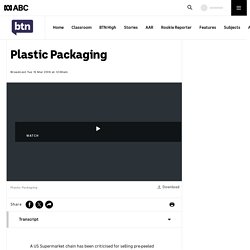
Open up the lunchbox, unwrap your food and throw away the packaging. But all that waste can really start to add up. In fact, in just one year the average Aussie throws away 200 kilograms of packaging. Environment groups say that adds up to almost 2 million tonnes across Australia every single year. That's one of the reasons why people were outraged when they saw this photo from the US of a peeled mandarin in a plastic container. And some even posted their own examples of unnecessary packaging. After the backlash the company took the mandarins off its shelves and even tried to have a bit of a laugh about it. So some conservation groups are calling on those food companies to start thinking about the environment, above convenience, and ditch the excess packaging. JO HENDRIKS, KESAB: I think we've lost our minds and that we really need to think about what we're buying. And there's a way you can help too.
Wipe Out Waste - Classroom - BTN. These guys are taking out the trash.
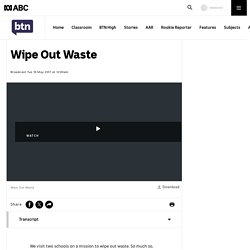
But they're making sure they've sorted it first. Here at Immanuel primary talking rubbish is encouraged. STEVIE: We're sorting the rubbish from our landfill bins into groups like organic, paper and cardboard, 10c bottles and things like that and plastic. They're just one of the schools on a huge mission to reduce, reuse and recycle just about everything. Sustainable Me. Clearing Everest's Trash - 360. BBC Earth Regeneration: Food. TED Ed Earth School - The clothes we wear. Before you dive into the rest of this Quest, check out these videos for more info about how your clothing is connected to nature and how your clothing choices can have an impact: Watch 1: Growing and Harvesting Cotton (Kansas Farm Bureau) Watch 2: Why Organic Cotton Matters (Prana)Watch 3: How Your T-Shirt Can Make a Difference (Nat Geo)Watch 4: What Will People Wear in the Future?
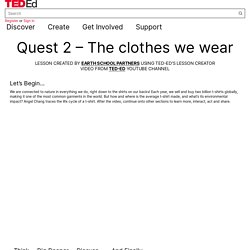
LEARN + INTERACTCreate a travel diary of your favorite piece of clothing. Write a story about the adventures of a cotton seed from the field to your wardrobe. (for all ages)Calculate your closet by taking a look at the label on your shirt. Waste Ban (2015) - BTN. ELOISE FUSS, REPORTING: It can be a hard life for food.
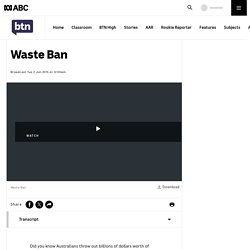
You wait expectantly in the supermarket to be chosen, finally someone buys you, you make it into a lunchbox, and then. Unfortunately, this is how lots of our food ends up. In Australia we waste huge amounts of food each year. How much exactly? Well, here goes. We throw out 20% of the food we buy, that's 1 in 5 bags of groceries, gone. But it's not just us throwing out heaps of food, supermarkets do it too. So things like these wonky carrots and other funny shaped fruit that's actually fine to eat, are instead tossed away. Each piece of food we toss away is a waste of the resources that went into making it.
It's also food that could be feeding hungry people. REPORTER: Stop! Well over in France, they're cracking down on food waste. Here in Australia, organisations like Oz Harvest are trying to rescue food before it reaches bins. What really happens to the plastic you throw away - Emma. If you watched this video, you’re probably interested in how plastics are made, and what impact they have on the environment.
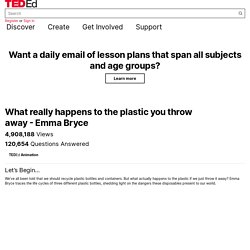
For starters, you might want to watch this video that shows you how plastic bottles are produced. The American Chemistry Council also has some helpful guidelines on how the material is manufactured, what different types there are, and what role monomers and polymers play in the manufacturing process. (What are monomers and polymers anyway? You can read more about how they’re used in plastics, here.) Moving on from the molecular stuff, plastic also has more visible impacts on the earth. TED Ed - The nurdles’ quest for ocean domination. Captain Charles Moore was the first to discover a large collection of plastics circulating in the Pacific Ocean.
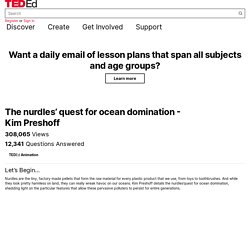
Take a look at this TED-Ed lesson Seas of Plastic: Captain Charles Moore to learn more about his discovery of the Great Pacific Garbage Patch. Where do the nurdles and microplastic floating in the ocean go? Often, they are deposited on the beaches of islands near the circulating ocean gyres. Midway, an island in the Pacific, is home to a large albatross population that is currently suffering from the plastic pollution floating in our oceans. View some photos here and watch A Midway Journey: Plastic Beach to learn about this story. Plastic bags are not indigenous to the Pacific Ocean! The Anthropocene or Age of Man, has become a popular term to represent the geologic epoch that marks the global impact humans have had on Earth’s ecosystems.
The Majestic Plastic Bag - A Mockumentary. Ask Producers to Help Save our Seas and $8 billion per year! Tidying Up with Marie Kondo.